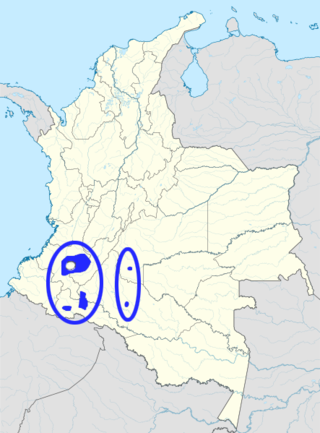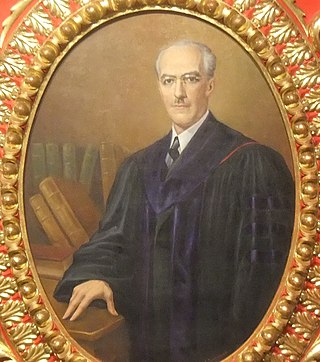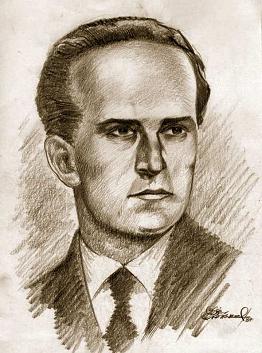Related Research Articles

This is a list of different language classification proposals developed for the indigenous languages of the Americas. The article is divided into North, Central, and South America sections; however, the classifications do not correspond to these divisions.
Paezan may be any of several hypothetical or obsolete language-family proposals of Colombia and Ecuador named after the Paez language.

The Chicham languages, also known as Jivaroan is a small language family of northern Peru and eastern Ecuador.

Páez is a language of Colombia, spoken by the Páez people. Crevels (2011) estimates 60,000 speakers out of an ethnic population of 140,000.
Chimuan or Yuncan is a hypothetical small extinct language family of northern Peru and Ecuador.

Jorge Carrera Andrade was an Ecuadorian poet, historian, author, and diplomat during the 20th century. He was born in Quito, Ecuador in 1902. He died in 1978. During his life and after his death he has been recognized with Jorge Luis Borges, Vicente Huidobro, Gabriela Mistral, Pablo Neruda, Octavio Paz and Cesar Vallejo as one of the most important Latin American poets of the twentieth century.
Jacinto Caamaño Moraleja was the leader of the last great Spanish exploration of Alaska and the coast of what is now British Columbia. He was a Knight of the Military Order of Calatrava.

The Quitu were Pre-Columbian indigenous peoples in Ecuador who founded Quito, which is the capital of present-day Ecuador. This people ruled the territory from 2000 BCE and persisted through the period known as the Regional Integration Period. They were overtaken by the invasion of the Inca. The Spanish invaded and conquered the center in 1534.

The Cara culture flourished in coastal Ecuador, in what is now Manabí Province, in the first millennium CE.

Sechura–Catacao is a proposed connection between the small Catacaoan language family of Peru and the language isolate Sechura (Sek). The languages are extremely poorly known, but Kaufman (1990) finds the connection convincing, Campbell (2012) persuasive.

Juan de Velasco y Pérez Petroche (1727–1792) was an 18th-century Jesuit priest, historian, and professor of philosophy and theology from the Royal Audience of Quito. He was born in Riobamba to Juan de Velasco y López de Moncayo and to María Pérez Petroche. Among the universities where he taught was the Universidad de San Marcos in Lima in the Viceroyalty of Peru. He is best known for his history book Historia del Reino de Quito, although he also wrote books in fields other than history, such as physics textbooks and poetry anthologies.

Jacinto Jijón y Caamaño was an Ecuadorian historian, archeologist, and politician. He was the mayor of the city of Quito from 1946 to 1948. He was a member of the Ecuadorian parliament and a candidate for the presidency of Ecuador. He published several works about the pre-Hispanic history of cultures in Ecuador.

The Manteño-Huancavilca civilization were one of the last pre-Columbian civilization in modern-day Ecuador, active from 850 to 1600 CE. It encompasses the area of the earlier Valdivia culture.
The extinct Palta language of the Ecuadorian Amazon is attested by only a few words: yumé 'water', xeme 'maize', capal 'fire', let 'wood', and some toponyms. Based on this, Jacinto Jijón y Caamaño (1936) classified it as a Jivaroan language. Kaufman (1994) states that there is "little resemblance", but Adelaar (2004) finds the connection reasonable. In addition to these four words are toponyms, which commonly end in -anga, -numa, -namá. The latter two suggest the Jivaroan locative case suffix -num ~ -nam, and Torero (1993) notes that the last resembles Aguaruna (Jivaroan) namák(a) 'river' as well.

Humberto Fierro was an Ecuadorian poet who was part of a group known as the "Generación decapitada". The group is called "decapitada", or decapitated, because all its members committed suicide at a young age.

Alfredo Gangotena Fernandez Salvador was an Ecuadorian poet who wrote in French and Spanish.

Caamaño is a Spanish-language surname. It may refer to:

Dolores Marta Gracia de Gangotena y Jijón was an Ecuadorian art collector, conservationist. She was First Lady of Ecuador to Camilo Ponce Enríquez from 16 September 1956 to 31 August 1960.

María de las Mercedes Jijón de Vivanco y Chiriboga was the first First Lady of Ecuador, serving in that capacity twice alongside her husband, Juan José Flores.

Luis Enrique Marcial Gomezjurado Flores was an Ecuadorian painter, one of the most notable academic artists of the first decades of the 20th century. He specialized in the human figure and excelled in the portrait, also highlighted in Genre painting.
References
- ↑ Loukotka, Čestmír (1968). Classification of South American Indian languages . Los Angeles: UCLA Latin American Center.